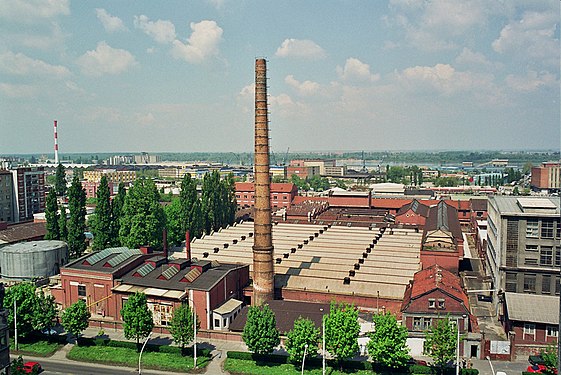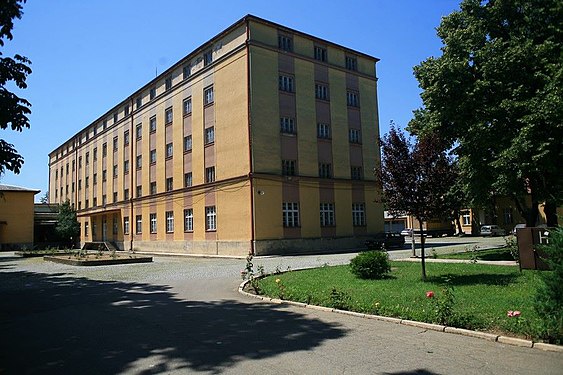GLAM/Newsletter/July 2018/Contents/Serbia report
|
Wikipedian in Residence at the Museum of Yugoslavia: History of Yugoslavia on Wikipedia
Wikipedian in Residence at the Museum of Yugoslavia: History of Yugoslavia on Wikipedia
This year's first Wikipedian in residence in cultural institutions was carried out at the Museum of Yugoslavia, being the first project funded by the Serbian Ministry of Culture and Information. The aim was to present the cultural and historical heritage, and the results are 100 articles on Serbian Wikipedia and 533 released files on Wikimedia Commons. Of that number, as many as 418 images have already been used to illustrate Wikipedia articles in nine languages!
The residence is a continuation of the successful cooperation with the Museum of Yugoslavia, whose leadership recognized the importance of visibility on Wikipedia and was eagerly awaiting the continuation of this program, which began at the end of last year. In addition to the highly successful edit-a-thon, Wikipedian Dušan Ružić spent one month in this institution, and for the first time numerous figures from Yugoslavia history had their Wikipedia pages created and illustrated.
However, all parties agreed that the job was not over and that there are many more subjects and figures from the history of Yugoslavia that deserve a place on the largest online encyclopedia. It was decided to repeat the residence, but this time the project was financed by the Serbian Ministry of Culture and Information. This time, master historian, Marko Stanojević was chosen for the task, being a dedicated Wikipedian with great interest for the period of Yugoslavia.

During the two-month residence at this institution, Marko devoted himself to creating new and improving existing articles using the literature kept in the museum. At the same time, the museum was releasing the photographs needed for their illustration. Marko's commitment, as well as the professionalism of the museum staff, who have always tried to provide adequate literature for the articles, successfully led to the article about the First Conference of the Non-Aligned Movement to be selected as a good article on Serbian Wikipedia.
Marko Stanojević, Wikipedian in residence, confirms that this article is unique because it currently exists only on Serbian Wikipedia:
- Jovana Nedeljković, the curator in the Museum of Yugoslavia, suggested me to write about this Movement and provided the sources. Thanks to that, I’ve created the best article of this internship project. The images donated by the Museum helped me demonstrate the real situation in Belgrade and during the Summit itself - Marko said.

Out of the 100 written articles, as many as 79 are about the Yugoslav national heroes, which means that Serbian Wikipedia now practically contains information about every notable hero of Yugoslav wars. Still, Radovan Cukić, Curator and head of the Museum of Yugoslavia’s Department of fund research and preservation, and Wikipedian in residence Marko specially mention the articles about photographers Mirko Lovrić and Aleksandar Simić. Mirko Lovrić, as an official photographer of president Josip Broz Tito, made a lot of photos during his visits to Africa and Asia. On the other hand, during the World War II, Aleksandar Simić was a photographer of Dragoljub Draža Mihajlović. He made a great number of images, including the one that made him famous. In that way, both of the anti-fascist movements are covered on Wikipedia.
- Even though we have now finished an important topic that was started a long time ago, and we have pages about all Yugoslav national heroes in Serbian Wikipedia, at the same time we started a new important topic of Industry of Yugoslavia. I would say that this time the most important articles are the ones that represent our new collections for the first time. Here I want to mention photo-legacy in the Museum of Yugoslavia, gifted by the photographers Mirko Lovrić and Aleksandar Simić. This time, we have showed to the public just a fragment of the historical treasure that is being preserved in our Museum, says Radovan Cukić.
In addition to the articles on Yugoslav heroes, Wikipedia has been enriched with pages on widely known companies that at the time were the bearers of the economical development, such as Prva petoletka, Ivo Lola Ribar, Belgrade cotton company, Sugar Factory Crvenka ... Radovan Cukić came to the idea to link these topics with an exhibition of the Museum of Science and technology "Time Keepers: Forgotten Industrial Heritage". This museum gladly responded to the invitation to contribute to Wikipedia and released 51 photographs of the companies in Yugoslavia, to illustrate the articles.
- Through analyzing the content of Serbian Wikipedia, we realized that there are extremely few pages on former Yugoslavia’s industry, and it really had to be corrected. The Museum of Science has been engaged in the topic of industrial heritage for a long time, thanks to Mr. Rifat Kulenović. After being transferred to the Museum of Yugoslavia in 2014, he continued leading the project under the auspices of the Museum of Yugoslavia, and when he returned to his primary institution in 2017 to become its director, the conditions for a more comprehensive cooperation between the two institutions on this topic were of exceptional significance. This resulted in an photo exhibition by Rifat Kulenović and Ada Vlajić "The Time Keepers: Forgotten Industrial Heritage" which could be seen in the Museum of Yugoslavia, and now, after several visits, it was installed at the Museum of Science. In that sense, Marko's article writing in cooperation with colleagues Ada and Rifat from the Museum of Science was the logical choice. Especially since, there are Ada’s and Rifat’s photographs on Wikipedia, showing the current state in which the factories that represent the industrial legacy of Serbia and Yugoslavia are - concludes Cukić.
As for the rare photographs that were missing on Wikipedia, we can mention the images of student demonstrations in Belgrade in 1968, Brioni Plenum in 1966, when Aleksandar Ranković was replaced, and photograph of President Tito with Theodore Castro, Kostarican Ambassador to Belgrade, who was actually a disguised Soviet operative.
- I would single out the page about Theodore Castro, the official ambassador of Costa Rica in Belgrade, who was in fact Stalin's agent with a task of killing Tito, written by Marko with excellence. It is, of course, illustrated with a very interesting photograph from his reception with Tito, from the photo archives of the Museum of Yugoslavia - explains Radovan.
We would also point out the encyclopedic value of the material, but also the novelty for the general public, which was the digitization of five photo albums, that the famous companies gave Tito as a gift. These are Energoprojekt from Belgrade, Ivo Lola Ribar from Železnik, Prva Petoletka from Trstenik, Red Flag from Kragujevac and Copper Mill from Sevojno. As they say in the Museum, it is enough to find out what kind of treasure for the researchers lies in over 2500 photo albums, mostly from the period of the Socialist Yugoslavia, which the Yugoslav Museum has inherited.
Everyone was pleased by the results, the process and the organization of this residence. The wider public - because it was given the opportunity to further learn the history of Yugoslavia on the most visited site of the modern age; the Museum of Yugoslavia - because for the first time new museum collections were presented; the Museum of Science, which increased the visibility of a great exhibition on industrial heritage; the Wikipedian Community - who got the materials that were missing to improve the encyclopedia, but also the Wikipedian in Residence, who enjoyed in his professional work and contributed to free knowledge.
First and foremost, I would like to express my gratitude to the Head of the Department, Radovan Cukić, who provided me with unselfish help and guided me in the elimination of the many dilemmas that I had. Also, Jovana Nedeljković, as well as other employees of the Museum. It was a pleasure to work in this eminent institution. I am pleased that with this internship, the number of digitized material on Commons has increased and that the cooperation between the Museum and Wikimedia Serbia will continue in the future.
Marko Stanojević
Marko Stanojević really deserved all praise for his engagement in the Museum of Yugoslavia. He is a young man, but fully developed in a professional sense, educated and formed historian, with a developed critical apparatus, but also a commitment to the period and topics he had the opportunity to deal with in the Museum of Yugoslavia. In short, an associate for every recommendation. Radovan Cukić
Wikimedia Serbia wants to thank all the participants of this project, especially regarding the satisfaction in establishing professional and exceptional partnership with the Museum of Yugoslavia, whose stability and long-term cooperation is of great importance for the development of the GLAM program in Serbia. We are planning new joint actions with this institution, which, we believe, will bring a lot of new, free knowledge to the largest encyclopedia in human history.
Hi all. This is just awesome; amazing work! Thanks for reporting. This is inspiring. --Joalpe (talk) 02:39, 11 August 2018 (UTC)
- Thank you @Joalpe. We are doing our best. :) --Ivana Guslarevic (talk) 14:30, 3 September 2018 (UTC)




















